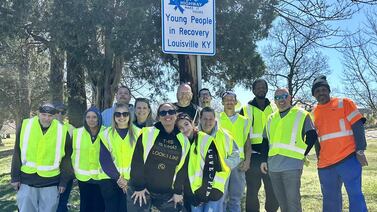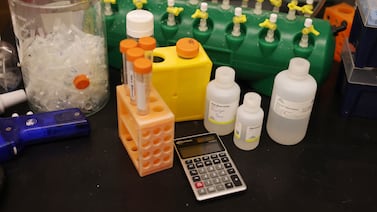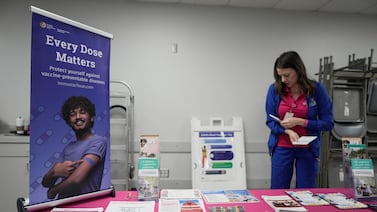Public health, explained: Sign up to receive Healthbeat’s free Atlanta newsletter here.
As the Georgia Opioid Crisis Abatement Trust prepares to distribute its first $50 million to address the overdose epidemic, state analyses show what prevention, harm reduction, treatment, and recovery resources Atlanta and the state need.
The analyses by the state’s Department of Behavioral Health and Developmental Disabilities on behalf of the trust focus on what services are missing in Georgia as a whole and different regions of the state.
The metro Atlanta region report points to a gap between the health needs of people with substance use disorder and the number of detox facilities, treatment centers, housing options, and addiction support services in the region — especially in Gwinnett County.
Kevin Tanner, the Department of Behavioral Health and Developmental Disabilities commissioner and the opioid trust’s manager, said these analyses will help him decide where he’ll award funding before the end of the year. The trust received over 300 grant applications earlier this year, according to a department spokesperson.
“That’s going to be the measuring stick we’re going to be using as we start looking at which grants should be funded,” Tanner said.
Over the past few years, Georgia’s overdose deaths have eclipsed all precedence in the state. The death rate in the state and the Atlanta region has tripled over the past two decades, as over 2,500 Georgia residents fatally overdosed in 2023.
Across the country, much of this rapid rise in overdose death has been attributed to companies within the pharmaceutical supply chain, which experts allege marketed and dispensed addictive opioid pain medications in ways that endangered the public. Studies show those past practices continue to have deadly consequences.
To address that harm, over a dozen companies have agreed to collectively pay over $50 billion to states across the country. Georgia is set to receive $638 million of those funds from AmerisourceBergen, Cardinal Health, Janssen Pharmaceuticals, and McKesson over the next 18 years. Settlement transparency groups expect the state will also receive around $200 million from Allergan, CVS, Mallinckrodt Pharmaceuticals, Teva Pharmaceuticals, Walgreens, and Walmart.
After attorney’s fees, a quarter of that money will go directly to local governments, and the remainder will go to the state’s Opioid Trust — with Tanner at the helm and a group of government officials advising him.
Gwinnett County lacks many drug recovery services
While the Behavioral Health Department’s statewide analysis found that Northern Georgia and Atlanta have more resources than other areas, its regional reports found needs in every part of the state.
In the metro Atlanta region, some of the sparsest services are centers for people to detox safely and housing for people early in their recovery. The report says Dekalb is the only county in the area that has both men’s and women’s recovery housing, which researchers view as crucial for addressing substance use disorder.
Gwinnett County, with a population of nearly 1 million, has neither services and lacks many other important ones, according to the report. Many ZIP codes in the county are economically disadvantaged, which the Behavioral Health Department says could be further adding to residents’ risk of a fatal overdose.
The government advisory group is set to meet publicly for the first time in mid-November and recommend how Tanner should award about $50 million of Opioid Trust funding. The public notice will go out soon, but a firm date for the meeting hasn’t been set, Tanner said. Soon after that meeting, he expects to grant the first round of funding.
Bill Carruthers, executive director of the Conyers addiction recovery support center Grit and Grace, is optimistic about how Georgia’s opioid settlements could help people with substance use disorders.
His nonprofit organization helps people, especially those who have recently left jail or prison, stay in recovery by connecting them with peer support, employment aid, and other resources. It also maintains a vending machine for the overdose-reversing drug naloxone at its building.
But he knows metro Atlanta organizations like Grit and Grace, which had a budget of $46,000 in 2022, need more money to bolster their services and help more people. While working on other grants kept him from applying for settlement money this year, Carruthers is pleased that a Rockdale group he closely partners with — Stepping Up Initiative — submitted a funding request.
“All one big team,” he said.
When the government advisory committee meets, it will also be reviewing the recommendations of councils representing six Georgia regions — which have been conducting workshops over the summer. Those meetings have not been open to the public, but Tanner said the council compositions are representative of the community’s interests, and their recommendations aren’t final.
By discussing these recommendations at a public meeting, publishing every winning application on the Trust’s website, and using a third-party group to evaluate whether Georgia’s overdose crisis is abating, Tanner hopes Georgia residents will be confident that funds are being well spent.
“We’ve brought in experts to really look at what do we currently have in Georgia and what are we missing,” he said. “And that’s what we’re going to be funding.”
Some groups more vulnerable in overdose crisis
Some of those experts are at the Emory University School of Medicine. Addiction psychiatrist Dr. Santosh Patel, who works in the university’s Department of Psychiatry and Behavioral Sciences, said he and his colleagues collaborated frequently with Tanner on his overdose response efforts with the trust and the state behavioral health department.
He said he was pleased to see Tanner incorporated some of their recommendations into the analyses the Opioid Trust published, and the reports do a good job considering all the different resources needed to help Georgians with substance use disorders.
But it is important, Patel said, to keep in mind that there are groups more vulnerable than others to the overdose crisis’ most harmful and deadliest impacts — groups like racial minorities, LGBTQ+ residents, pregnant Georgians, and people who are or have been incarcerated. He also expressed the desire to see more programs developed specifically for kids at risk of developing addictions.
He said the focus of these funding decisions should always be what can help those who have suffered the most in the past and may suffer the most in the future.
“Having the money to back up some good ideas is going to be incredibly important,” Patel said.
Carruthers sees the Georgia settlements as an opportunity to not only fund good ideas but also create a coordinated, collaborative, and sustainable approach to address addiction in the area.
He knows Georgians with addictions need both immediate aid and long-term solutions — and one nonprofit or government group can’t do it all.
“Somebody has to have the five-year plan, somebody has to have the five-minute plan,” he said.
Allen Siegler is a reporter covering public health in Atlanta for Healthbeat. Contact Allen at asiegler@healthbeat.org.






